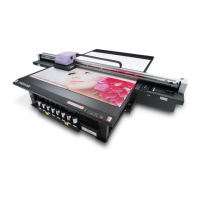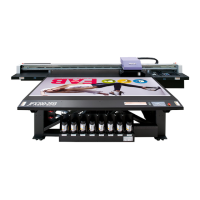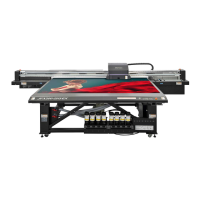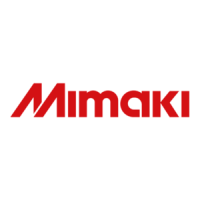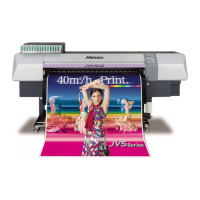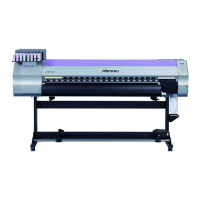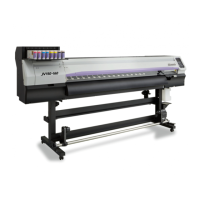Chapter 5 Troubleshooting
133
Symptom / Points to check Corrective action
5. Perform the procedure described in "Carriage Underside
Cleaning"(P. 118).
Offsetting occurs during bidirectional
printing.
1. Perform the procedure described in "Correcting the Drop
Position"(P. 75).
Ink droplets drip during printing.
1. Perform the procedure described in "Wiper Cleaning"(P. 114).
2. Perform the procedure described in "Cap Rubber Cleaning"(P. 116).
3. Perform the procedure described in "Carriage Underside
Cleaning"(P. 118).
4. Perform the procedure described in "Head Cleaning"(P. 73).
5. Set auto maintenance. "Maintenance menu"(P. 101)
Clear clogged nozzles.
1. Perform the procedure described in "Head Cleaning"(P. 73).
2. Perform the procedure described in "Wiper Cleaning"(P. 114).
3. Perform the procedure described in "Cap Rubber Cleaning"(P. 116).
4. Perform the procedure described in "Ink fillup (Print head)"(P. 133).
5. Perform the procedure described in "Wiper Replacement"(P. 123).
6. Set [MAINTENANCE] > [Nozzle recovery] > [Nozzle recovery] to "On".
Is the head gap excessive? Reduce the head gap. If the head gap cannot be reduced, increase
flushing frequency during printing ( "Maintenance menu"(P. 101))
or make regular test prints to check for nozzle clogging.
Are certain ink colors used
infrequently?
Increase the refresh level ( "Setting 1 Menu"(P. 104)) during
printing. Discharge from infrequently used nozzles tends to be
inconsistent. Increasing the refresh level will allow more frequent
nozzle use but increase ink consumption.
Are you using media readily affected
by static electricity?
Increase flushing intervals during printing ( "Maintenance
menu"(P. 101) "Setting 1 Menu"(P. 104)) or make regular test
prints to check for nozzle clogging. Otherwise, use an optional
ionizer.
Are you using mirrors, polished
stainless steel plate, or gold or silver
foil media?
When using reflective media, increase the flushing interval increase
flushing frequency during printing ( "Setting 1 Menu"(P. 104)) or
make regular test prints to check for nozzle clogging.
Are you using media with an uneven
surface?
More light is reflected by uneven media than flat media. To reduce
reflected light from sources other than the media, reduce
unevenness as much as possible by loading unneeded media
(thinner than the media used for printing) on the suction surface of
the table even where no media is loaded.
Is the machine installed in a location
with low humidity?
Increase the humidity by installing a humidifier or similar equipment.
When printing continuously, increase flushing frequency during
printing ( "Setting 1 Menu"(P. 104)) or make regular test prints to
check for nozzle clogging. Otherwise, use an optional ionizer.
Is the machine installed in a location
with significant amounts of airborne
dust or powder?
Install the machine in a location free of excessive dust or powder
(office equivalent: dust levels = 0.15 mg/m
3
). If the printer is installed
elsewhere, make regular test prints to confirm no nozzle clogging
occurs.
Ink fillup (Print head)
If ejection failures (e.g., nozzle clogging or deflection) remain unresolved even after head cleaning (
"Head Cleaning"(P. 73)), perform head filling.
1
From MENU on the touch panel, tap [MAINTENANCE].
• The Maintenance menu is displayed.
5

